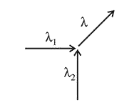Two particles move at right angle to each other. Their de Broglie wavelengths are $\lambda_{1}$ and $\lambda_{2}$ respectively. The particles suffer perfectly inelastic collision. The de Broglie wavelength $\lambda$, of the final particle, is given by:
Correct Option: 1
(1) From the de-Broglie relation,
$p_{1}=\frac{h}{\lambda_{1}}$
$p_{2}=\frac{h}{\lambda_{2}}$

Momentum of the final particle $\left(\mathrm{p}_{\mathrm{f}}\right)$ is given by
$\therefore \quad p_{f}=\sqrt{p_{1}^{2}+p_{2}^{2}}$
$\Rightarrow \frac{h}{\lambda}=\sqrt{\frac{h^{2}}{\lambda_{1}^{2}}+\frac{h^{2}}{\lambda_{2}^{2}}}$
$\Rightarrow \frac{1}{\lambda^{2}}=\frac{1}{\lambda_{1}^{2}}+\frac{1}{\lambda_{2}^{2}}$
Click here to get exam-ready with eSaral
For making your preparation journey smoother of JEE, NEET and Class 8 to 10, grab our app now.
